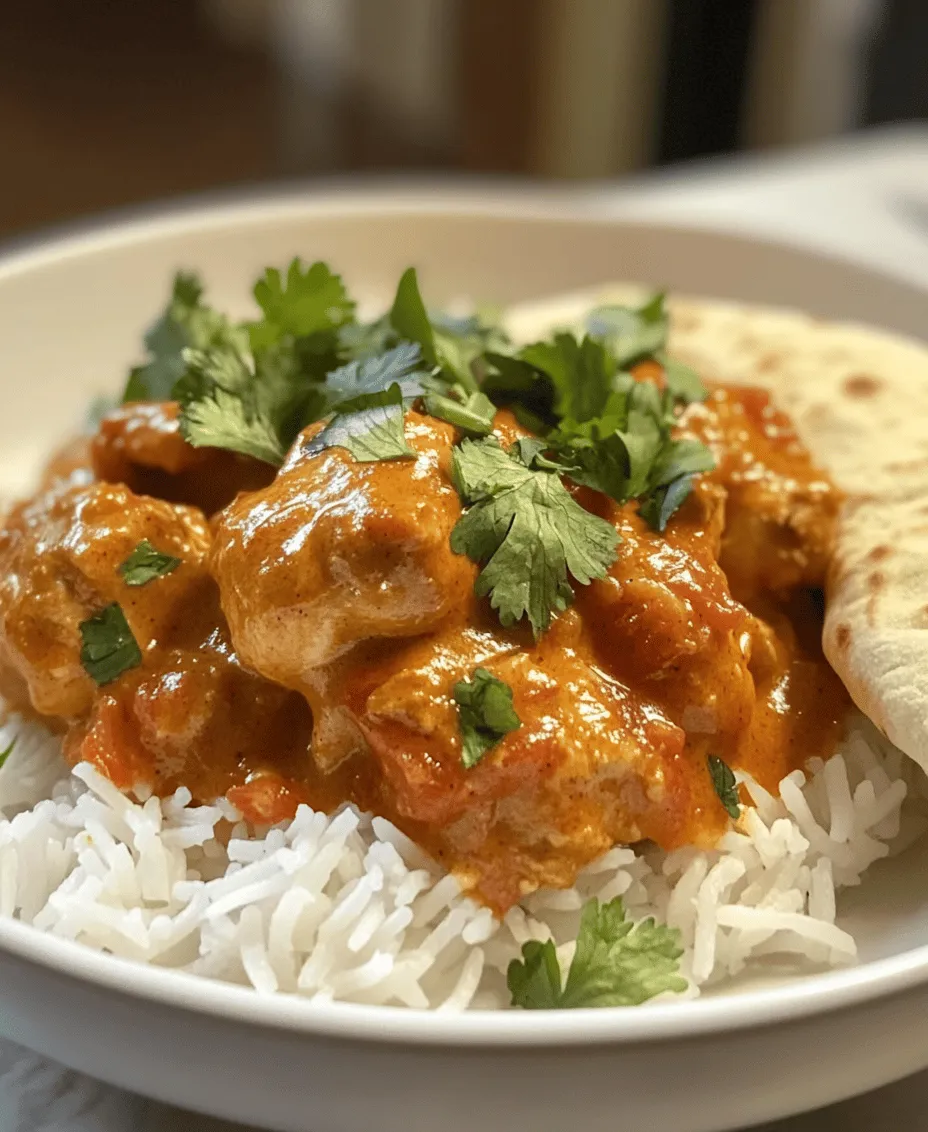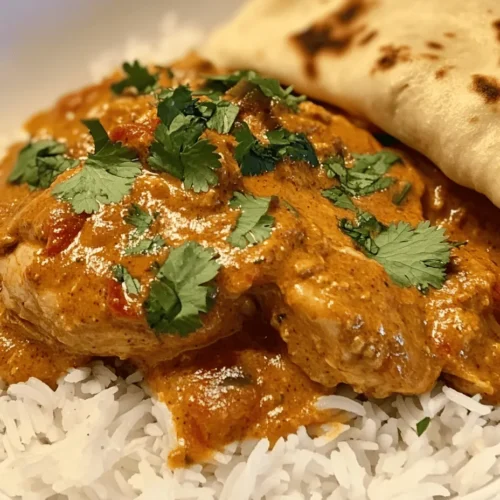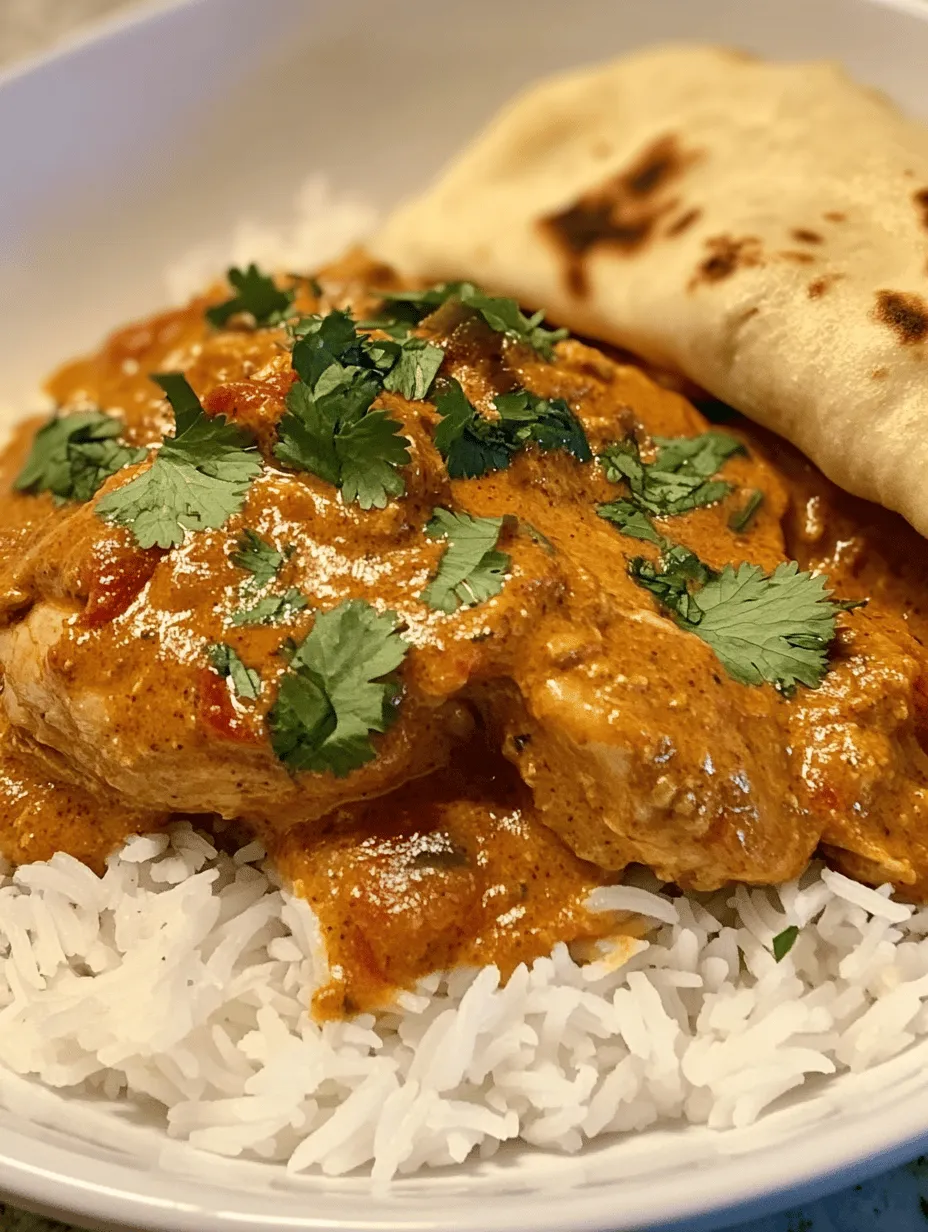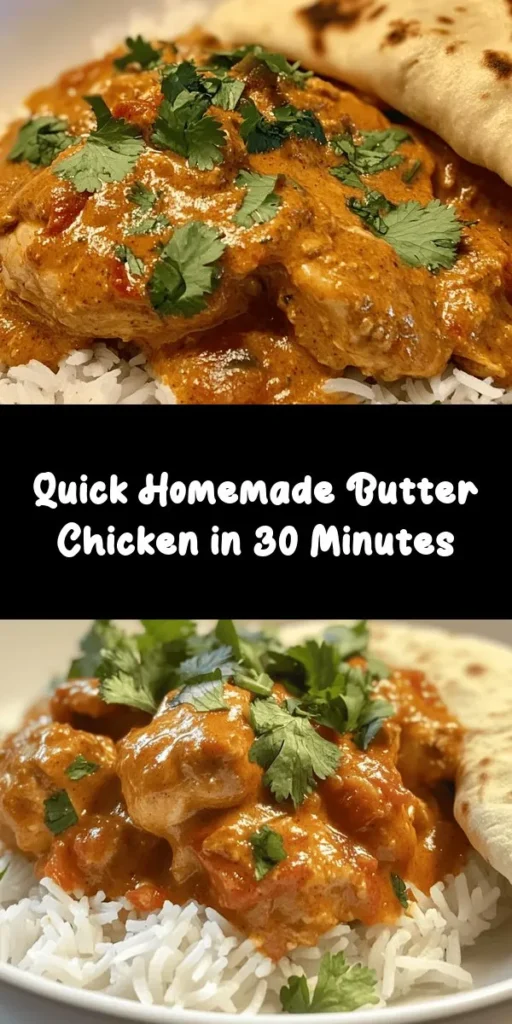Introduction
Homemade butter chicken is a beloved dish that brings the rich and aromatic flavors of Indian cuisine right into your kitchen. This quick and easy recipe is perfect for busy weeknights or impressing guests with minimal effort. With tender chicken thighs simmered in a creamy tomato sauce and aromatic spices, you can create a restaurant-quality meal at home in just 30 minutes. In this article, we will explore the origins of butter chicken, its key ingredients, and step-by-step instructions to ensure a perfect dish every time.
The Origins of Butter Chicken
Exploring the Rich History of Butter Chicken
Butter chicken, or “Murgh Makhani,” has a fascinating history that traces back to the 1940s in Delhi, India. It was created by the chefs at the Moti Mahal restaurant, who sought to utilize leftover chicken in a new and delicious way. The dish was born from a combination of leftover tandoori chicken, which was simmered in a tomato-based sauce enriched with butter and cream. This innovative approach not only salvaged the leftovers but also gave birth to a culinary masterpiece that would soon captivate taste buds around the world.
The dish quickly gained popularity due to its rich flavors and creamy texture, making it a staple in Indian households and restaurants. Its rapid rise to fame is attributed to the harmonious blend of spices and ingredients that create a comforting meal perfect for any occasion. Today, butter chicken is synonymous with Indian cuisine and is celebrated worldwide, often enjoyed with naan or rice.
Understanding the Cultural Significance
Butter chicken is more than just a dish; it represents the vibrant culture of Indian cuisine. The use of spices in Indian cooking is deeply rooted in tradition, with each ingredient serving both flavor and health benefits. For instance, ingredients like ginger, garlic, and various spices not only enhance taste but also contribute to wellness, showcasing the holistic approach of Indian culinary practices.
Moreover, butter chicken has become a symbol of India’s culinary diversity, showcasing how regional ingredients and cooking methods can come together to create a globally recognized dish. It is often served during festivals, family gatherings, and special occasions, signifying hospitality and warmth. The act of sharing a meal of butter chicken reflects the spirit of togetherness, making it a cherished recipe among families.
Butter Chicken’s Popularity in Global Cuisine
As Indian cuisine has gained traction around the world, butter chicken has emerged as one of its most popular dishes. Its creamy texture and mildly spiced flavor profile make it accessible to a wide audience, appealing to both those new to Indian food and seasoned aficionados. In countries like the United States, Canada, and the United Kingdom, butter chicken has found its way into mainstream menus, often featured in Indian restaurants and fusion eateries.
The dish’s adaptability also contributes to its popularity. Many chefs and home cooks have experimented with variations, incorporating local ingredients or altering spice levels to suit different palates. Whether served on a traditional Indian platter or as part of a modern fusion meal, butter chicken remains a beloved choice for many, showcasing the universal appeal of flavorful comfort food.
Key Ingredients for Quick & Easy Homemade Butter Chicken
Creating a delicious butter chicken at home starts with understanding its key ingredients. Each component plays a vital role in achieving the dish’s signature taste and texture. Here are the essential ingredients you’ll need to make this quick and easy homemade butter chicken:
– Boneless Chicken Thighs: Why They Are Ideal
When it comes to butter chicken, boneless chicken thighs are the preferred choice for many chefs. Unlike chicken breasts, thighs are inherently juicier and more flavorful due to their higher fat content. This ensures that the chicken remains tender and moist even after cooking, absorbing the rich flavors of the marinade and sauce beautifully. Moreover, thighs are less likely to dry out, making them an excellent option for quick cooking methods.
– Aromatics: The Role of Onion, Garlic, and Ginger
Aromatics are the backbone of any great butter chicken recipe. Onions, garlic, and ginger not only add depth of flavor but also contribute to the dish’s aromatic profile. Onions provide sweetness and a slight thickness to the sauce, while garlic and ginger add a zesty kick that enhances the overall flavor. When sautéed together, these ingredients create a fragrant base that sets the stage for the rest of the dish.
– Tomato Puree: The Foundation of Flavor
The heart of butter chicken lies in its rich, tomato-based sauce. Tomato puree is essential for creating the vibrant color and tangy flavor that defines this dish. It acts as a canvas for the spices and other ingredients, blending them into a cohesive sauce. The natural acidity of the tomatoes balances the richness of the cream and butter, ensuring a harmonious flavor profile.
– Cream: Creating the Signature Richness
Cream is what gives butter chicken its luxurious texture. It adds a velvety richness to the sauce that coats the chicken beautifully. While heavy cream is traditional, you can also use half-and-half or coconut cream for a lighter or dairy-free option. The cream’s richness is essential in tempering the spices, creating a smooth and balanced dish that is both indulgent and comforting.
– Spices: The Heart of Indian Cooking
The spices used in butter chicken are what elevate the dish from simple to extraordinary. A blend of spices such as garam masala, cumin, turmeric, and chili powder creates the distinctive flavor profile. Garam masala, a warm spice blend, is particularly important, infusing the dish with a fragrant aroma and depth of flavor. Each spice contributes its unique character, making the dish complex yet approachable.
– Garnishes: Enhancing Presentation and Flavor
While the main components of butter chicken are crucial, garnishes play an important role in the dish’s final presentation and flavor. Fresh cilantro is the most common garnish, adding a pop of color and a refreshing herbal note that brightens the rich sauce. A drizzle of cream or a sprinkle of crushed cashews can also enhance the visual appeal, making your homemade butter chicken not just delicious but also beautiful.
Preparation Steps for Homemade Butter Chicken
Now that we have explored the origins and key ingredients of butter chicken, let’s dive into the preparation steps that will guide you in making this delectable dish.
Marinating the Chicken
Importance of Marination
Marinating the chicken is a crucial step in achieving tender, flavorful meat. The marinade allows the spices and yogurt to penetrate the chicken, infusing it with flavor and moisture. A well-marinated chicken will not only taste better but will also have a more appealing texture when cooked.
Recommended Marinade Ingredients
For your butter chicken marinade, combine yogurt, lemon juice, garam masala, turmeric, chili powder, and salt in a bowl. The yogurt acts as a tenderizer, while the spices impart essential flavor. You can marinate the chicken for at least 30 minutes, but for best results, aim for 2 hours or overnight in the refrigerator. This extended marination will enhance the flavors and ensure that your chicken is juicy and flavorful.
Cooking the Chicken
Optimal Cooking Techniques for Tender Chicken
Cooking the marinated chicken properly is essential for achieving the perfect butter chicken. Begin by preheating your skillet or pan over medium-high heat. Add a little oil or butter to the pan to prevent sticking and enhance flavor. Sear the chicken thighs for about 5-7 minutes on each side until they are golden brown and cooked through. This technique not only locks in moisture but also adds a beautiful caramelization that enhances the overall flavor of the dish.
Tips for Achieving the Perfect Brown
To achieve that perfect golden-brown crust, avoid overcrowding the pan. Cook the chicken in batches if necessary, allowing enough space for the meat to sear properly. Once the chicken is cooked, remove it from the pan and set it aside to rest while you prepare the sauce. This resting period helps the juices redistribute, keeping the chicken tender and moist.
Sautéing the Aromatics
Now it’s time to build the flavors of your butter chicken. In the same pan used for cooking the chicken, add chopped onions and sauté them until they are soft and translucent. This process usually takes about 5 minutes. The fond left in the pan from the chicken will add depth to the sauce, enhancing the overall flavor profile.
Once the onions are ready, add minced garlic and ginger, continuing to sauté for another minute. Be careful not to burn the garlic, as it can turn bitter. Once fragrant, add the tomato puree to the pan, stirring well to combine all the ingredients. Allow the mixture to simmer for a few minutes, letting the flavors meld together.
As the sauce thickens, you can add in the cream and any remaining spices, stirring until everything is well incorporated. This will create the luscious, creamy sauce that butter chicken is famous for.
With these steps, you’ve laid the groundwork for a delicious homemade butter chicken that will impress family and friends alike. Stay tuned for the continuation of this recipe, where we’ll cover additional tips and final touches to perfect your dish.

Understanding Flavor Development
Creating a delicious butter chicken requires an understanding of flavor development, which is critical to achieving the authentic taste that this dish is renowned for. The heart of butter chicken lies in layering flavors throughout the cooking process. Starting with the base ingredients—onions, garlic, and ginger—you create a robust foundation that will enhance the overall dish.
During the cooking process, it is essential to focus on the timing of adding these aromatics. This allows for the gradual release of their essential oils and flavors, which is key to the depth of taste in your sauce.
Timing for Onions, Garlic, and Ginger
Start by finely chopping your onions, garlic, and ginger. Each ingredient plays a specific role in building the flavor profile.
1. Onions: Sauté the onions first until they become translucent. This usually takes about 5-7 minutes over medium heat. The goal is to soften them, which brings out their natural sweetness.
2. Garlic and Ginger: After the onions have softened, add minced garlic and grated ginger. Sauté these for an additional 1-2 minutes until fragrant. Be careful not to burn them, as burnt garlic can impart a bitter flavor to your sauce.
By perfecting the timing of these ingredients, you lay the groundwork for a well-balanced and flavorful sauce that will coat your chicken beautifully.
Creating the Sauce
Once your aromatics are ready, it’s time to build the sauce. This part of the process is crucial, as it determines the final texture and flavor of your butter chicken.
Balancing Flavors with Spices
The right blend of spices is essential in achieving the signature taste of butter chicken. Common spices used include:
– Garam Masala: This spice blend adds warmth and complexity.
– Turmeric: Provides a beautiful golden color and earthy flavor.
– Cumin: Adds a smoky, nutty flavor.
– Coriander: Offers a citrus-like flavor that brightens the dish.
Once your aromatics are ready, sprinkle in your spices and toast them for about 30 seconds. This step releases the essential oils in the spices and enhances their flavors, making your sauce richer and more aromatic.
Tips for Simmering: Achieving the Right Consistency
After you’ve added the spices, it’s time to incorporate the tomato puree. A good quality tomato puree will yield a smoother sauce. Stir in the puree and allow it to simmer for about 10 minutes, allowing the flavors to meld together.
The consistency of your sauce is important. If it seems too thick, add a bit of water or chicken broth to reach your desired consistency. Conversely, if it’s too thin, let it simmer a bit longer to reduce and thicken.
Combining Chicken and Sauce
Now that your sauce is prepared, it’s time to add the chicken.
The Process of Adding Cream
Once the chicken pieces are cooked through, lower the heat and add in the cream. The cream is essential for achieving the rich, buttery flavor that butter chicken is known for. Stir gently to combine, ensuring the chicken is well-coated with the sauce.
Adjusting Seasoning for Perfect Flavor
Before serving, it’s crucial to taste and adjust the seasoning. You may find that it needs a bit more salt, or perhaps a touch of sugar to balance the acidity of the tomatoes. A squeeze of fresh lime juice can also brighten the dish and enhance the flavors.
Serving Suggestions
Butter chicken is often served with a variety of accompaniments that enhance the overall dining experience.
Pairing with Rice or Naan
One of the most popular ways to enjoy butter chicken is with a side of rice or naan.
Best Types of Rice for Butter Chicken
Basmati rice is the traditional choice, known for its fluffy texture and fragrant aroma. It complements the rich sauce perfectly. Alternatively, jasmine rice or even cauliflower rice can be used for a low-carb option.
Exploring Different Varieties of Naan
Naan is another classic pairing. You can choose from plain naan, garlic naan, or even butter naan for an extra indulgent experience. Each type adds a different flavor profile and texture, making your meal more enjoyable.
Garnishing for Visual Appeal
Adding garnishes not only enhances the visual appeal but also contributes additional layers of flavor.
Using Fresh Cilantro Effectively
Fresh cilantro is a common garnish for butter chicken. It adds a pop of color and a fresh, herbal note that contrasts beautifully with the rich sauce. Roughly chop the cilantro and sprinkle it generously over the dish just before serving.
Other Garnish Options to Consider
Consider adding a dollop of yogurt or a sprinkle of red chili flakes for a touch of heat. You could also serve with lemon wedges, which can be squeezed over the dish for added brightness.
Nutritional Information
Understanding the nutritional value of butter chicken can help you make informed choices about your meal.
Breaking Down the Nutritional Value
Each serving of homemade butter chicken typically contains:
– Calories Per Serving: Approximately 400-500 calories depending on the amount of cream and oil used.
– Key Nutrients in Butter Chicken: This dish provides protein from the chicken, healthy fats from the cream, and various vitamins and minerals from the spices and aromatics. The tomatoes also contribute antioxidants like lycopene.
Healthier Modifications for Dietary Needs
To make butter chicken lighter, consider using less cream or substituting with Greek yogurt. You can also increase the vegetable content by adding bell peppers or spinach. These modifications not only reduce calories but also enhance the nutritional profile of the dish.
Conclusion
In conclusion, this quick and easy homemade butter chicken recipe offers a perfect blend of flavors that can be enjoyed by everyone. The simplicity of the preparation process makes it accessible for both novice and experienced cooks alike, while its rich taste guarantees satisfaction at the dinner table. With the right ingredients and a few straightforward steps, you can bring a taste of India into your home, delighting your family and friends with this comforting dish. Whether served over rice or paired with naan, butter chicken is sure to become a favorite in your meal rotation.



